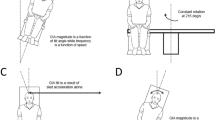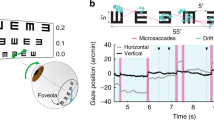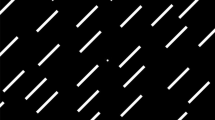Abstract
A CYCLOROTARY eye movement is a motor response of the eye made around the visual axis. Counter-rolling of the eye, for example, occurs during lateral head tilt1–5; conjugate rotary nystagmus can be induced by a large rotating field6–9; and disjunctive cyclotorsions can occur during ordinary convergence10,11. Because none of these torsional eye movements can be produced as an isolated voluntary response, eye torsion has always been classified as an involuntary response, a reflex. Using a visual-feedback procedure, however, we have trained humans to make conjugate voluntary cyclotorsional eye movements up to 30 degrees in magnitude12. We have also demonstrated that these large torsional movements are not visually induced and can be made in the absence of any visual stimulus. Accompanying the training and performance of these eye movements were a number of striking illusions related to one's own sense of body orientation. Because these newly trained eye movements are unprecedented, it is of interest to characterise accompanying illusions in detail, comparing them with other illusions of self rotation induced through vestibular13 and visual14,15 inputs. In this paper we compare the effects of trained cyclorotary eye movements with head and whole body tilts, showing a quantitatively similar change in egocentric orientation for each type of tilt. As such, our findings suggest the possibility of shared mechanisms affecting the stability of one's internal frame of reference, both for eye and body movements.
This is a preview of subscription content, access via your institution
Access options
Subscribe to this journal
Receive 51 print issues and online access
$199.00 per year
only $3.90 per issue
Buy this article
- Purchase on Springer Link
- Instant access to full article PDF
Prices may be subject to local taxes which are calculated during checkout
Similar content being viewed by others
References
Davis, T. & Merton, P. A. J. Physiol., Lond. 140, 25P–27P (1957).
Miller, E. F. US Naval School of Aviation Medicine Research, Report no. 75, 1–32 (1962).
Colenbrander, A. Ophthalmologia 146, 309–313 (1963).
Belcher, S. J. Br. J. physiol. Opt. 2, 1–6 (1964).
Petrov, A. P. & Zenkin, G. M. Vision Res. 13, 2465–2477 (1973).
Brecher, G. A. Pflügers Arch. Ges. Physiol. 234, 13–17 (1934).
Kertesz, A. E. & Jones, R. W. Vision Res. 9, 995–998 (1969).
Crone, R. A. Albrecht T. Graefes Arch. klin. exp. Ophthal. 196, 1–7 (1975).
Crone, R. A. & Eberhard-Halm, Albrecht T. Graefes Arch. klin. exp. Ophthal. 195, 231–239 (1975).
Allen, M. J. Am. J. Optom. Arch. Am. Acad. Optom. June, 297–307 (1954).
Allen, M. J. & Carter, J. H. Am. J. Optom. Arch. Am. Acad. Optom. 44, 343–349 (1967).
Balliet, R. & Nakayama, K. Invest. Ophthal. 17, 303–314 (1978).
Ormsby, C. C. & Young, L. R. Aviat. Space Environ. Med. 47(2), 159–164 (1976).
Held, R., Dichgans, J. & Bauer, J. Vision Res. 15, 357–365 (1975).
Dichgans, J., Held, R., Young, L. R. & Science 178, 1217–1219 (1972).
Young, L. R., Dichgans, J., Murphy, R. & Brandt, T. Acta Otolaryng. 76, 24–31 (1973).
Howard, I. P. & Templeton, W. B. Human Spatial Orientation, 175–195 (Wiley, London, 1966).
MacFarland, J. H., Wapner, S. & Werner, S. Percept. Mot. Skills 15, 331–341 (1962).
Nakayama, K. & Balliet, R. Vision Res. 17, 453–457 (1977).
Klinke, R. & Schmidt, C. L. Pflügers Arch. Ges. Physiol. 318, 325–332 (1970).
Dichgans, J. & Brandt, Th. in Cerebral Control of Eye Movements and Motion Perception (eds Dichgans, J. & Bizzi, E.) 327–338 (S. Karger, New York, 1972).
Dichgans, J., Schmidt, C. L. & Graf, W. Expl Brain Res. 18, 319–322 (1973).
Henn, V., Young, L. R. & Finley, C. Brain Res. 71, 146–149 (1974).
Author information
Authors and Affiliations
Rights and permissions
About this article
Cite this article
BALLIET, R., NAKAYAMA, K. Egocentric orientation is influenced by trained voluntary cyclorotary eye movements. Nature 275, 214–216 (1978). https://doi.org/10.1038/275214a0
Received:
Accepted:
Issue Date:
DOI: https://doi.org/10.1038/275214a0
Comments
By submitting a comment you agree to abide by our Terms and Community Guidelines. If you find something abusive or that does not comply with our terms or guidelines please flag it as inappropriate.



